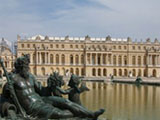 |
 |
The châteaux of Louis XIV
Versailles, the symbol of both absolute monarchy and the Revolution which destroyed it, was the main residence of Louis XIV. An art and culture enthusiast, he applied his desire for grandeur and cultural development to architecture. This gave rise to the colonnade at the Louvre, the Hôtel des Invalides, Place Vendôme and, of course, the Château de Versailles. In 1682, with his court and his government, the King settled into the Château de Versailles, a better symbol of his power and influence in Europe.
|


